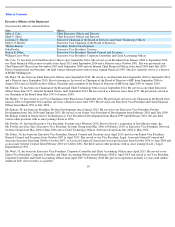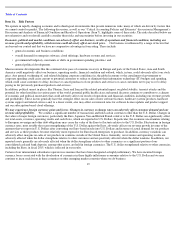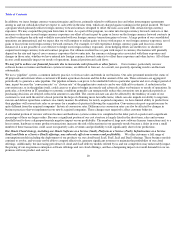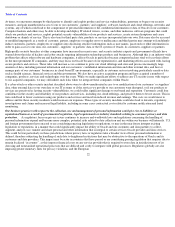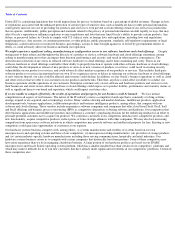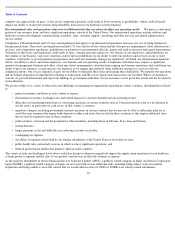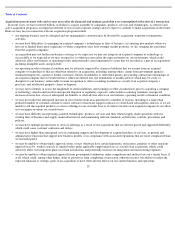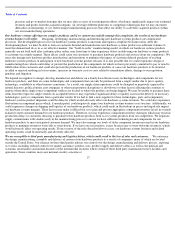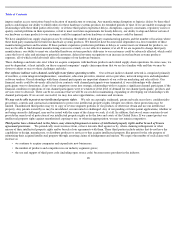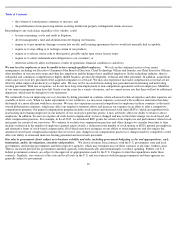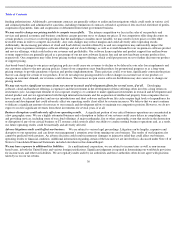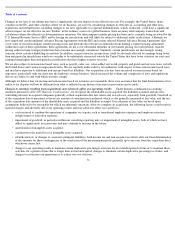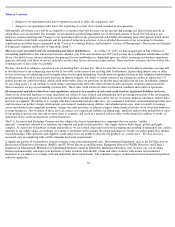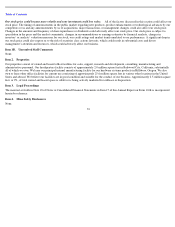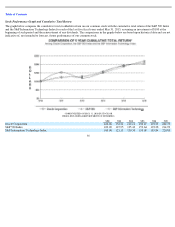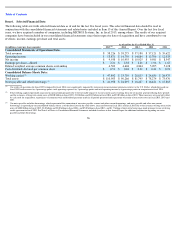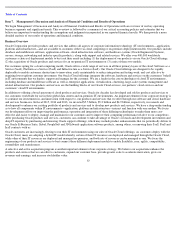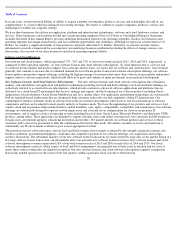Oracle 2014 Annual Report Download - page 32
Download and view the complete annual report
Please find page 32 of the 2014 Oracle annual report below. You can navigate through the pages in the report by either clicking on the pages listed below, or by using the keyword search tool below to find specific information within the annual report.
Table of Contents
impose market access restrictions based on location of manufacture or sourcing. Any manufacturing disruption or logistics delays by these third
parties could impair our ability to fulfill orders for these hardware systems products for extended periods of time. If we are unable to manage our
relationships with these third parties effectively, or if these third parties experience delays, disruptions, capacity constraints, regulatory issues or
quality control problems in their operations, or fail to meet our future requirements for timely delivery, our ability to ship and deliver certain of
our hardware systems products to our customers could be impaired and our hardware systems business could be harmed.
We have simplified our supply chain processes by reducing the number of third party manufacturing partners and the number of locations where
these third party manufacturers build our hardware systems products. We therefore have become more dependent on a fewer number of these
manufacturing partners and locations. If these partners experience production problems or delays or cannot meet our demand for products, we
may not be able to find alternate manufacturing sources in a timely or cost effective manner, if at all. If we are required to change third party
manufacturers, our ability to meet our scheduled hardware systems products deliveries to our customers could be adversely affected, which could
cause the loss of sales and existing or potential customers, delayed revenue recognition or an increase in our hardware systems products
expenses, all of which could adversely affect the margins of our hardware business.
These challenges and risks also exist when we acquire companies with hardware products and related supply chain operations. In some cases, we
may be dependent, at least initially, on these acquired companies’ supply chain operations that we are less familiar with and thus we may be
slower to adjust or react to these challenges and risks.
Our software indirect sales channel could affect our future operating results. Our software indirect channel network is comprised primarily
of resellers, system integrators/implementers, consultants, education providers, internet service providers, network integrators and independent
software vendors. Our relationships with these channel participants are important elements of our software marketing and sales efforts. Our
financial results could be adversely affected if our contracts with channel participants were terminated, if our relationships with channel
participants were to deteriorate, if any of our competitors enter into strategic relationships with or acquire a significant channel participant, if the
financial condition or operations of our channel participants were to weaken or if the level of demand for our channel participants’ products and
services were to decrease. There can be no assurance that we will be successful in maintaining, expanding or developing our relationships with
channel participants. If we are not successful, we may lose sales opportunities, customers and revenues.
We may not be able to protect our intellectual property rights. We rely on copyright, trademark, patent and trade secret laws, confidentiality
procedures, controls and contractual commitments to protect our intellectual property rights. Despite our efforts, these protections may be
limited. Unauthorized third parties may try to copy or reverse engineer portions of our products or otherwise obtain and use our intellectual
property. Any patents owned by us may be invalidated, circumvented or challenged. Any of our pending or future patent applications, whether or
not being currently challenged, may not be issued with the scope of the claims we seek, if at all. In addition, the laws of some countries do not
provide the same level of protection of our intellectual property rights as do the laws and courts of the United States. If we cannot protect our
intellectual property rights against unauthorized copying or use, or other misappropriation, we may not remain competitive.
Third parties have claimed and, in the future, may claim infringement or misuse of intellectual property rights and/or breach of license
agreement provisions. We periodically receive notices from, or have lawsuits filed against us by, others claiming infringement or other
misuse of their intellectual property rights and/or breach of our agreements with them. These third parties include entities that do not have the
capabilities to design, manufacture, or distribute products or services or that acquire intellectual property like patents for the sole purpose of
monetizing their acquired intellectual property through asserting claims of infringement and misuse. We expect the number of such claims will
increase as:
28
•
we continue to acquire companies and expand into new businesses;
•
the number of products and competitors in our industry segments grows;
•
the use and support of third party code (including open source code) becomes more prevalent in the industry;


